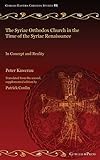The Syriac Orthodox Church in the Time of the Syriac Renaissance : In Concept and Reality / Peter Kawerau, Patrick Conlin.
Material type: TextSeries: Gorgias Eastern Christian Studies ; 64Publisher: Piscataway, NJ : Gorgias Press, [2022]Copyright date: 2022Description: 1 online resource (246 p.)Content type:
TextSeries: Gorgias Eastern Christian Studies ; 64Publisher: Piscataway, NJ : Gorgias Press, [2022]Copyright date: 2022Description: 1 online resource (246 p.)Content type: - 9781463244675
- 9781463244682
- 281.9/5691 23/eng/20230221
- BX173.2 .K3913 2022
- BX173.2
- online - DeGruyter
| Item type | Current library | Call number | URL | Status | Notes | Barcode | |
|---|---|---|---|---|---|---|---|
 eBook
eBook
|
Biblioteca "Angelicum" Pont. Univ. S.Tommaso d'Aquino Nuvola online | online - DeGruyter (Browse shelf(Opens below)) | Online access | Not for loan (Accesso limitato) | Accesso per gli utenti autorizzati / Access for authorized users | (dgr)9781463244682 |
Browsing Biblioteca "Angelicum" Pont. Univ. S.Tommaso d'Aquino shelves, Shelving location: Nuvola online Close shelf browser (Hides shelf browser)

|

|

|

|

|

|

|
||
| online - DeGruyter Codex Washingtonianus : An Analysis of the Textual Affiliations of the Freer Gospels Manuscript / | online - DeGruyter On Knowing God : Interdisciplinary Theological Perspectives / | online - DeGruyter Jacob of Sarug's Homily on Paul's Word to Seek What is Above and on Outer Darkness / | online - DeGruyter The Syriac Orthodox Church in the Time of the Syriac Renaissance : In Concept and Reality / | online - DeGruyter Jacob of Sarug’s Homilies on Abgar and Addai. | online - DeGruyter Jacob of Sarug's Homily Concerning the Red Heifer and the Crucifixion of our Lord / | online - DeGruyter Shbītho. |
Frontmatter -- TABLE OF CONTENTS -- TRANSLATOR’S PREFACE -- FOREWORD -- INTRODUCTION -- THE ORGANIZATION OF THE SYRIAC ORTHODOX CHURCHES -- THE INNER LIFE OF THE SYRIAC ORTHODOX CHURCH -- THE RELATIONSHIP OF THE SYRIAC ORTHODOX CHURCH TO OTHER CHRISTIAN CHURCHES -- THE RELATIONSHIP OF THE SYRIAC ORTHODOX CHURCH TO THE NONCHRISTIAN ENVIRONMENT -- APPENDIX -- BIBLIOGRAPHY -- PLATES
restricted access online access with authorization star
http://purl.org/coar/access_right/c_16ec
The Syriac Orthodox Church experienced a revival of writing and theological insight during the 11th – 13th centuries known as the Syriac Renaissance. Authors like Bar ʿEbroyo, Michael I Rabo (Michael the Great) and Dionysios Bar Salibi authored their own original works and translated Greek and Arabic writings into Syriac. However, then as now, grand ecclesiastical plans sometimes fell short of real life application. This time period was also a significant one in secular history, with Crusaders, Muslims, and Mongol khans battling for control of the Middle East. After scouring the available Syriac chronicles from the Syriac Renaissance, Peter Kawerau has summarized both the stated ideals and lived realities of ecclesiastic structures and interactions between Syriac-speaking Christians and their neighbors of other traditions and faiths. Most of the information here comes from Bar ʿEbroyo's and Michael I Rabo's chronicles, although other sources are referenced as well. Peter Kawerau (1915–1988) was a German scholar of church history, focusing on the eastern churches. He studied theology at the Universities of Wroclaw and Berlin. In 1949, after World War II, he earned his doctorate at the University of Göttingen, with this book being a version of his dissertation. He did his Habilitationsschrift in 1956 at Münster. He would go on to teach at the University of Marburg where he founded the Ostkirchen Institut. His corpus includes works on Protestant, Syriac, African, and Byzantine church history. This work was part of his Habilitationsschrift and originally published in 1955 with an updated edition in 1960. This translation, based on the 1960 edition, updates some of the language used and makes this work available to English speaking students, scholars, and interested laity.
Mode of access: Internet via World Wide Web.
In English.
Description based on online resource; title from PDF title page (publisher's Web site, viewed 26. Aug 2024)


